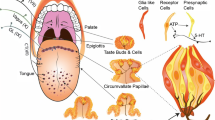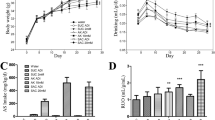Abstract
The sweet taste is of immense interest to scientists and has been intensively studied during the last two decades. However, the sweet preference modification and the related mechanisms are still unclear. In this study, we try to establish a mice model with manipulated sweet taste preference and explore the involved possible molecular mechanisms. The animals were exposed to acesulfame-K via maternal milk during lactation and the sweet preference tests were carried out when they grew to adulthood. Our results showed that the preference thresholds for sweet taste were increased in adults by early acesulfame-K exposure and the preference ratios for sweet tastants at low or preferred concentrations were decreased. Moreover, by means of qRT-PCR and Western blot, we observed the increased expression of leptin receptor Ob-Rb and downregulation of Gα-gustducin protein in the soft palate. Thereby, the sweet taste sensitivity may be modified by early sweetener experience during lactation. Along the peripheral sweet sensory pathway, the sweet regulator receptors Ob-Rb, CB1 and components of sweet transduction signal Gα-gustducin and T1R2 in both the soft palate and tongue may be cooperatively involved in the plastic development of sweet taste.




Similar content being viewed by others
References
Armenta S, Garrigues S, de la Guardia M (2004) FTIR determination of aspartame and acesulfame-K in tabletop sweeteners. J Agric Food Chem 52:7798–7803
Bachmanov AA, Tordoff MG, Beauchamp GK (1998) Voluntary sodium chloride consumption by mice: differences among five inbred strains. Behav Genet 28:117–124
Bachmanov AA, Tordoff MG, Beauchamp GK (2001) Sweetener preference of C57BL/6ByJ and 129P3/J mice. Chem Senses 26:905–913
Bandyopadhyay A, Ghoshal S, Mukherjee A (2008) Genotoxicity testing of low-calorie sweeteners: aspartame, acesulfame-K, and saccharin. Drug Chem Toxicol 31:447–457
Beauchamp GK, Mennella JA (2011) Flavor perception in human infants: development and functional significance. Digestion 83(Suppl 1):1–6
Beidler LM, Smallman RL (1965) Renewal of cells within taste buds. J Cell Biol 27:263–272
Bernstein IL, Fenner DP, Diaz J (1986) Influence of taste stimulation during the suckling period on adult taste preference in rats. Physiol Behav 36:913–919
Coleman J, Williams A, Phan TH et al (2011) Strain differences in the neural, behavioral, and molecular correlates of sweet and salty taste in naive, ethanol- and sucrose-exposed P and NP rats. J Neurophysiol 106:2606–2621
Cooke L, Fildes A (2011) The impact of flavour exposure in utero and during milk feeding on food acceptance at weaning and beyond. Appetite 57:808–811
Farbman AI (1980) Renewal of taste bud cells in rat circumvalate papillae. Cell Tissue Kinet 13:349–357
Fuller JL (1974) Single-locus control of saccharin preference in mice. J Hered 65:33–36
Gaillard D, Barlow LA (2011) Taste bud cells of adult mice are responsive to Wnt/beta-catenin signaling: implications for the renewal of mature taste cells. Genesis 49:295–306
Hendricks SJ, Brunjes PC, Hill DL (2004) Taste bud cell dynamics during normal and sodium-restricted development. J Comp Neurol 472:173–182
Hill DL (2001) Taste development. In: Blass E (ed) Handbook of behavioral neurobiology, developmental psychobiology, vol 13. Plenum, New York, pp 517–549
Horne J, Lawless HT, Speirs W, Sposato D (2002) Bitter taste of saccharin and acesulfame-K. Chem Senses 27:31–38
Hoshishima K, Yokoyama S, Seto K (1962) Taste sensitivity in various strains of mice. Am J Physiol 202:1200–1204
Jyotaki M, Shigemura N, Ninomiya Y (2010) Modulation of sweet taste sensitivity by orexigenic and anorexigenic factors. Endocr J 57:467–475
Kawai K, Sugimoto K, Nakashima K, Miura H, Ninomiya Y (2000) Leptin as a modulator of sweet taste sensitivities in mice. Proc Natl Acad Sci U S A 97:11044–11049
Keskitalo K, Tuorila H, Spector TD et al (2007) Same genetic components underlie different measures of sweet taste preference. Am J Clin Nutr 86:1663–1669
Li X, Staszewski L, Xu H, Durick K, Zoller M, Adler E (2002) Human receptors for sweet and umami taste. Proc Natl Acad Sci U S A 99:4692–4696
Liem DG, Mennella JA (2002) Sweet and sour preferences during childhood: role of early experiences. Dev Psychobiol 41:388–395
Liu D, Liman ER (2003) Intracellular Ca2+ and the phospholipid PIP2 regulate the taste transduction ion channel TRPM5. Proc Natl Acad Sci U S A 100:15160–15165
Marlin NA (1983) Early exposure to sugars influences the sugar preference of the adult rat. Physiol Behav 31:619–623
Martin B, Shin YK, White CM et al (2010) Vasoactive intestinal peptide-null mice demonstrate enhanced sweet taste preference, dysglycemia, and reduced taste bud leptin receptor expression. Diabetes 59:1143–1152
Mennella JA, Trabulsi JC (2012) Complementary foods and flavor experiences: setting the foundation. Ann Nutr Metab 60(Suppl 2):40–50
Mennella JA, Jagnow CP, Beauchamp GK (2001) Prenatal and postnatal flavor learning by human infants. Pediatrics 107:E88
Mistretta CM (1972) Topographical and histological study of the developing rat tongue, palate and taste buds. In: Bosma JF (ed) Third symposium on oral sensation and perception: the mouth of the infant. C.C. Thomas, Springfield, pp 163–187
Mistretta CM, Hill DL (2003) Development of the taste system: basic neurobiology. In: Doty RL (ed) Handbook of olfaction and gestation, 2nd edn. Marcel Dekker, New York, pp 759–782
Miura H, Nakayama A, Shindo Y, Kusakabe Y, Tomonari H, Harada S (2007) Expression of gustducin overlaps with that of type III IP3 receptor in taste buds of the rat soft palate. Chem Senses 32:689–696
Mukherjee A, Chakrabarti J (1997) In vivo cytogenetic studies on mice exposed to acesulfame-K—a non-nutritive sweetener. Food Chem Toxicol 35:1177–1179
Nakamura Y, Sanematsu K, Ohta R et al (2008) Diurnal variation of human sweet taste recognition thresholds is correlated with plasma leptin levels. Diabetes 57:2661–2665
Nelson G, Hoon MA, Chandrashekar J, Zhang Y, Ryba NJ, Zuker CS (2001) Mammalian sweet taste receptors. Cell 106:381–390
Ninomiya Y (1998) Reinnervation of cross-regenerated gustatory nerve fibers into amiloride-sensitive and amiloride-insensitive taste receptor cells. Proc Natl Acad Sci U S A 95:5347–5350
Ninomiya Y, Sako N, Imai Y (1995) Enhanced gustatory neural responses to sugars in the diabetic db/db mouse. Am J Physiol 269(4 Pt 2):R930–937
NTP (2005) NTP toxicology studies of acesulfame potassium (CAS no. 55589-62-3) in genetically modified (FVB Tg.AC hemizygous) mice and carcinogenicity studies of acesulfame potassium in genetically modified [B6.129-Trp53(tm1Brd) (N5) Haploinsufficient] mice (feed studies) mice. Natl Toxicol Program Genet Modif Model Rep (2):1-113
Pelz WE, Whitney G, Smith JC (1973) Genetic influences on saccharin preference of mice. Physiol Behav 10:263–265
Reed DR, McDaniel AH (2006) The human sweet tooth. BMC Oral Health 6(Suppl 1):S17
Reed DR, Li S, Li X et al (2004) Polymorphisms in the taste receptor gene (Tas1r3) region are associated with saccharin preference in 30 mouse strains. J Neurosci 24:938–946
Roth TL, Sweatt JD (2009) Regulation of chromatin structure in memory formation. Curr Opin Neurobiol 19:336–342
Roth TL, Sweatt JD (2011) Annual research review: epigenetic mechanisms and environmental shaping of the brain during sensitive periods of development. J Child Psychol Psychiatry 52:398–408
Sato N, Shimizu H, Shimomura Y, Uehara Y, Takahashi M, Negishi M (1991) Sucrose feeding at weaning alters the preference for sucrose in adolescence. Exp Clin Endocrinol 98:201–206
Sclafani A (2006) Enhanced sucrose and polycose preference in sweet “sensitive” (C57BL/6J) and “subsensitive” (129P3/J) mice after experience with these saccharides. Physiol Behav 87:745–756
Shigemura N, Ohta R, Kusakabe Y et al (2004) Leptin modulates behavioral responses to sweet substances by influencing peripheral taste structures. Endocrinology 145:839–847
Shin YK, Cong WN, Cai H et al (2012) Age-related changes in mouse taste bud morphology, hormone expression, and taste responsivity. J Gerontol A Biol Sci Med Sci 67:336–344
Stevens DA (1996) Individual differences in taste perception. Food Chem 56:303–311
Stockton MD, Whitney G (1974) Effects of genotype, sugar, and concentration on sugar preference of laboratory mice (Mus musculus). J Comp Physiol Psychol 86:62–68
Stone LM, Barrows J, Finger TE, Kinnamon SC (2007) Expression of T1Rs and gustducin in palatal taste buds of mice. Chem Senses 32:255–262
Strahl BD, Allis CD (2000) The language of covalent histone modifications. Nature 40:41–45
Tomonari H, Miura H, Nakayama A et al (2012) Gα-gustducin is extensively coexpressed with sweet and bitter taste receptors in both the soft palate and fungiform papillae but has a different functional significance. Chem Senses 37:241–251
Wong GT, Ruiz-Avila L, Ming D, Gannon KS, Margolskee RF (1996) Biochemical and transgenic analysis of gustducin’s role in bitter and sweet transduction. Cold Spring Harb Symp Quant Biol 61:173–184
Wurtman JJ, Wurtman RJ (1979) Sucrose consumption early in life fails to modify the appetite of adult rats for sweet foods. Science 205:321–322
Yoshida R, Ohkuri T, Jyotaki M et al (2010) Endocannabinoids selectively enhance sweet taste. Proc Natl Acad Sci U S A 107:935–939
Zhang Y, Hoon MA, Chandrashekar J et al (2003) Coding of sweet, bitter, and umami tastes: different receptor cells sharing similar signaling pathways. Cell 112:293–301
Zhang GH, Chen ML, Liu SS et al (2010) Facilitation of the development of fungiform taste buds by early intraoral acesulfame-K stimulation to mice. J Neural Transm 117:1261–1264
Zhang GH, Chen ML, Liu SS et al (2011) Effects of mother's dietary exposure to acesulfame-K in Pregnancy or lactation on the adult offspring's sweet preference. Chem senses 36:763–770
Acknowledgments
The authors thank the reviewers for their great efforts in improving this manuscript. This work was supported by the National Natural Science Foundation of China (NSFC31140086; NSFC31200812), the Science and Technology Infrastructure Projects of Suzhou (SZSZD0904); the University Natural Science Research Project of Jiangsu Province (12KJB180001); and the Qing Lan Project of Jiangsu Provincial Education Department.
Author information
Authors and Affiliations
Corresponding author
Additional information
Authors Wei-Li Li and Meng-Ling Chen contributed equally to this work.
Rights and permissions
About this article
Cite this article
Li, WL., Chen, ML., Liu, SS. et al. Sweet Preference Modified by Early Experience in Mice and the Related Molecular Modulations on the Peripheral Pathway. J Mol Neurosci 51, 225–236 (2013). https://doi.org/10.1007/s12031-013-0011-y
Received:
Accepted:
Published:
Issue Date:
DOI: https://doi.org/10.1007/s12031-013-0011-y




